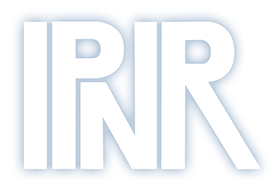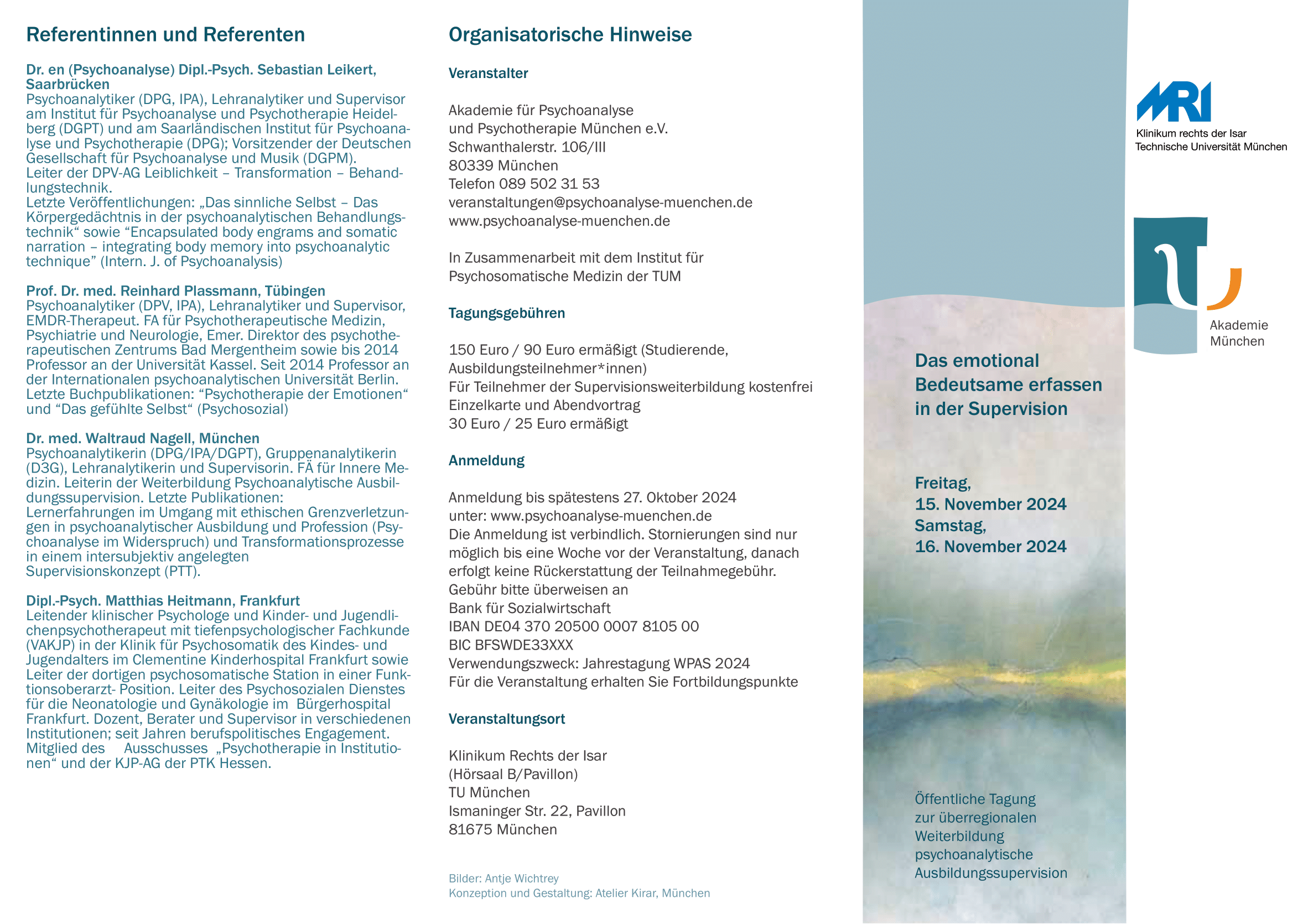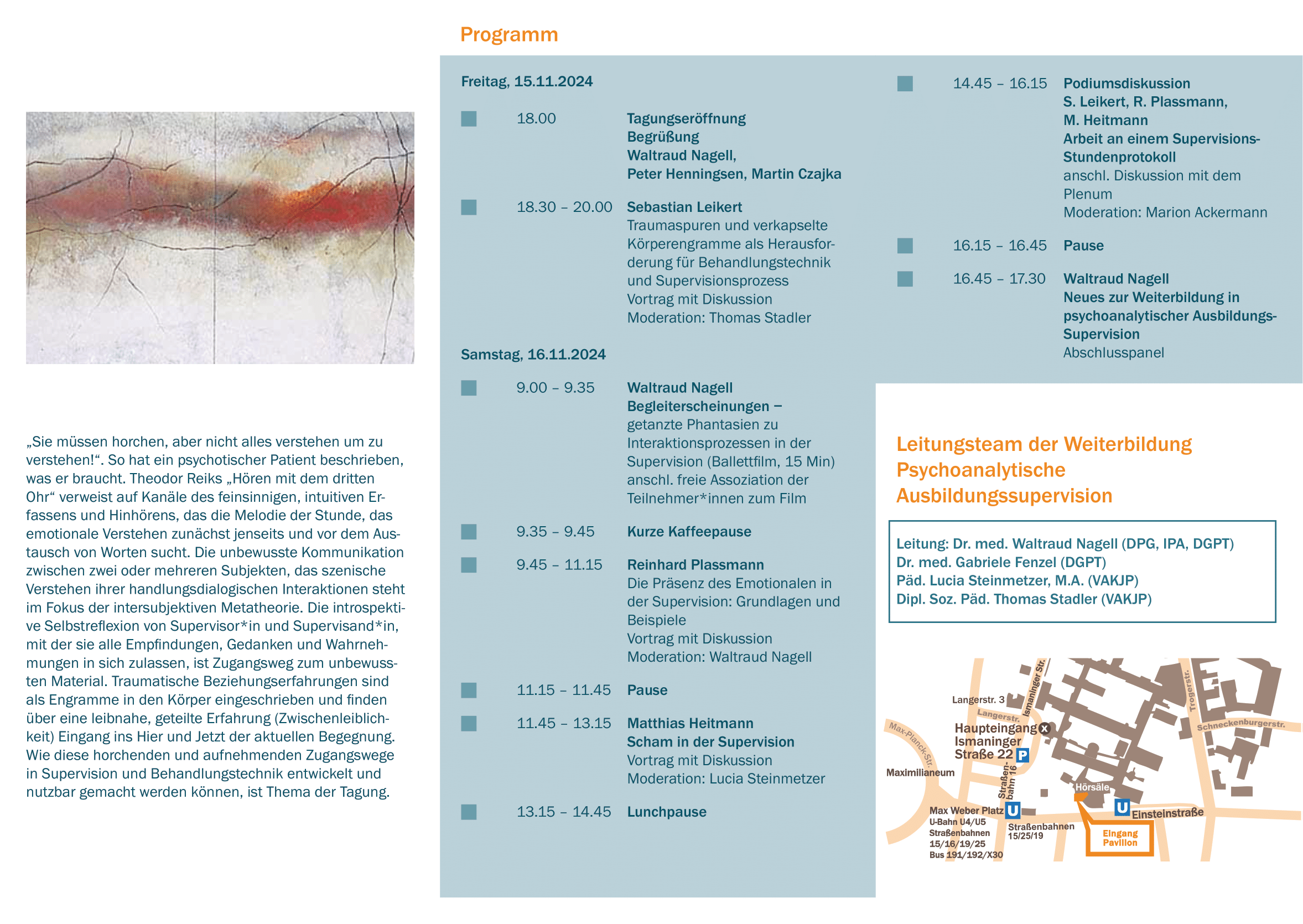und Psychotherapie Nürnberg
und psychotherapeutischen Institute
in Nürnberg und Regensburg

Institut für Psychoanalyse (DPG)
Nürnberg - Regensburg e. V.
Penzstraße 10 • 90419 Nürnberg
Sekretariat: E-Mail
Tel.: 0911-977 971 01

Institut für Psychoanalyse
und Psychotherapie von Kindern
und Jugendlichen Nürnberg e.V. (KIP)
Rieterstraße 6 • 90419 Nürnberg
Sekretariat: E-Mail
Tel. 0911-400 86 59

Institut für Psychodynamische
Psychotherapie Nürnberg e.V. (PIN)
Untere Baustraße 20 • 90478 Nürnberg
Sekretariat: E-Mail
Tel.: 0911-93783971
Nächste Termine
Die Veranstaltung findet in Kooperation mit "Bildung Evangelisch - Erwachsenenbildung im Dekanat Erlangen" statt. Fortbildungspunkte bei der Bayerischen Psychotherapeutenkammer sind beantragt.
Dr. phil. Hans-Ludwig Siemen ist Psychoanalytiker und in eigener Praxis in Erlangen niedergelassen.
The
9th Edition of the IPD/NPSA Rome Conference will take place on 25th and
26th January 2025. It will employ a hybrid format, offering the choice
of attendance either in person at Hotel D'Azeglio or online.
The conference will address the topic of body image construction, with a
focus on both theoretical research into its formation and clinical
research into eating disorders and dysmorphophobia.
On Saturday, a discussion on the construction of body image will draw
upon the perspectives of Philosophy of Mind (S. Gallagher), Neuroscience
(V. Gallese) and Neuroaesthetics (L. Oppenheim).
On Sunday, clinical cases and a panel discussion will address the
clinical issue of how to deal with body image disorders, with
contributions from the audience.
The conference will be delivered in English with simultaneous translation into Italian.
Early bird registration deadline: 30th September, 2024
Registration: www.ipdneuroscience.com
Program:https://drive.google.com/file/d/1VFgR7SM80DZ-INOQ7eH7dcd4nF0tSsOv/view?usp=drive_link
Die Veranstaltung findet in Kooperation mit "Bildung Evangelisch - Erwachsenenbildung im Dekanat Erlangen" statt. Fortbildungspunkte bei der Bayerischen Psychotherapeutenkammer werden beantragt.
Dipl. Psych. Caroline Scholz-Schneider ist Psychoanalytikerin und in eigener Praxis in Nürnberg niedergelassen.
In seiner langjährigen Geschichte hat sich das Symposion zum zentralen Forum der psychoanalysehistorischen Szene im deutschsprachigen Bereich herausgebildet. Das Programm wird in der Hauptsache nicht "gemacht", sondern repräsentiert laufende Arbeitsprojekte im Feld, soweit sie zum Vortrag angeboten werden. Die Mehrzahl der Referenten sind nicht-akademische Forscher, die gleichwohl akademisches Niveau anstreben. Auch akademische Autoren aus verschiedenen Fakultäten, vor allem jüngere, nutzen das Symposion zur Vorstellung einschlägiger Arbeiten.
Kontakt:
Ludger M. Hermanns: Diese E-Mail-Adresse ist vor Spambots geschützt! Zur Anzeige muss JavaScript eingeschaltet sein!
Rainer Herrn: rainer.herrn@charite.de
Andrea Huppke: a.huppke@web.de
Tagungsbüro (Sabine Selle): symposion-psycho@charite.de
23.–33. Symposion in Berlin, 2010–2020
34.–35. Symposion, 2021 und 2022: wegen Corona als Zoom-Veranstaltung
Programm 2024
Programm 2023
Programm 2022
Programm 2021
Programm 2020
Programm 2019
Programm 2018
Programm 2017
Programm 2016
Programm 2015
Programm 2014
Programm 2013
Programm 2012
Programm 2011
Programm 2010
Symposien 1–22 in Kassel und Tübingen
We are delighted to welcome you to the 38th Annual Conference of the EPF in Dresden where we have moved from Florence 2024 to "Florence on the Elbe" 2025. When you visit Dresden, you will realise that both its outstanding art collections, several buildings that characterise the cityscape and its geographical location on the Elbe have contributed to this reputation.
We have chosen "Freiheit - Freedom - Liberté" for this year's theme. We are continuing the tradition of the recent congresses, in which we were also inspired by a central notion for the various contributions: Realities (2021) - Ideals (2022) - Illusions (2023) - Identifications (2024). The theme of Freedom resonates with the numerous European crises. Our personal freedom as well as the freedom of our global European society is currently under threat by a range of different sociopolitical scenarios. We will reflect these scenarios in the individual contributions to our congress: all the more as they push into our consulting room and preoccupy us increasingly in our psychoanalytical federation, the EPF.
What does psychoanalysis have to say on the subject of 'freedom'? How is the concept of freedom related to the unconscious? How does it apply to clinical psychoanalysis and advance metapsychology?
In Freud's work, there are at least two thematic formulations in which the concept of freedom is highlighted. The first topic concerns the relationship between freedom and determinism. How free are we actually to choose and how much are our actions determined by our unconscious? In dream formation Freud writes:
"There is far less freedom and arbitrariness in mental life than we are inclined to assume; there may even be none at all" (Freud 1907 9); and when analysing parapraxes and slips, he speaks of the "illusion of such a thing as psychical freedom” (Freud 1916 49), which forbids us to regard slips of the tongue and other mistakes that are unconsciously motivated. These formulations by Freud cannot and should not surprise us, because without the assumption of psychic determination by the unconscious, dreams and parapraxes would be arbitrary, even random, and in any case unmotivated mental products. Thus psychoanalysis would be deprived of its foundations that is its raison d'être in the first place.
It would be just as far-reaching to believe that a causal determinism emanates from the unconscious. How could the analytic treatment lead to anything other than the parodistic explanation of the past through the present? Molière ingeniously and simply put it in the following phrase from his comedy The doctor in Spite of Himself: "And you see, that's why your daughter is mute". Freud's concept of the après-coup in particular - that only in the future will it become clear what the past is all about - cannot be conceived of without a minimum degree of psychological freedom. By no means must it be misunderstood as an explanation of the predetermination of our psychic life by early childhood influences. Laplanche in particular did a great deal to keep the après-coup free of any overly simplistic determinism, which is especially included in the English translation as "deferred action". But also Freud's description of the "effectiveness of analysis", namely that it should "give the patient's ego the freedom to decide one way or the other" (Freud 1923, 50, footnote 1, bold in original) would be untenable without the assumption of a certain psychological freedom.
And is it not a characteristic of the psychoanalytic vocabulary that it cannot work without an element of freedom? Isn’t this the reason why ‘overdetermination’ belongs to this vocabulary and simple ‘determinism’ does not? It’s not by chance that we call our fundamental rule ‘free association’. The tension between freedom and determinism which we just described is inherent in the notion itself.
The second thematic formulation deals with the meaning of freedom within Freud's theory of culture, as he developed it, for example, in "Civilization and its Discontents". In the context of his reflections on why our cultural life seems to impose all too many obstacles on the human pursuit of happiness, Freud also addresses freedom, or more precisely "the liberty of the individual”, and claims: “The liberty of the individual is no gift of civilization " (Freud 1930 96), in order to subsequently emphasise the eternal conflict between individual claims to freedom and cultural commandments as well as prohibitions. “No”, says Freud in the same passage, “…it does not seem as though any influence could induce a man to change his nature into a termite’s; no doubt he will always defend his claim to individual liberty against the will of the group" (ibid.). Freud understands individual freedom or liberty here, first and foremost, as "instinctual freedom" (ibid. 115), which would be permanently restricted, even damaged, by the impositions of culture. It is precisely this instinctual freedom that distinguishes the human "animal organism" (ibid. 105, footnote 2) from the termites, which are selflessly absorbed in their social function within an insect state, while the human instinctual being has an a-social side anchored in infantile sexuality, that is difficult to tame. How can we profitably take up Freud's far-reaching reflections on the relationship between freedom and culture at a time when the “discontent” in culture is palpable and is becoming more and more widespread from day to day?
Of the many authors who, inspired by Freud, have turned to the concept of freedom, let us single out Winnicott, who wrote two short, less recognized texts entitled "Freedom". Winnicott addresses the problem of psychological determinism, "…it is obviously very difficult...perhaps for all human beings, to accept determinism as a basic fact" (Winnicott, “Freedom”, 1969-1971, 80), with certain "environmental conditions" that contribute to the subjective feeling of freedom. He primarily focuses on severely disturbed patients whose inner freedom is restricted by mental illness. His deep humanism is reflected in the final sentence of one of the two essays, in which he ponders the background to happiness, health and freedom: "Those who are well enough and free enough must be able to endure the triumph which belongs to their state. Yet nothing but luck gave them the chance to be healthy" (Winnicott, “The Threat to Freedom”, 1969-1971, 87).
Beyond these few suggestions, we would like to invite you to take the liberty of thinking about freedom in and beyond psychoanalysis, and to attend the congress of the EPF 2025 in Dresden. So much has been left unsaid in this brief argument - especially the connection of our topic to the neighbouring sciences of psychoanalysis such as philosophy and art, literature and politics, so that your help in dealing with the topic of freedom is indispensable. Dresden seems to us to be exactly the right place for this: the city represents both the loss and regaining of freedom. In addition, it offers a variety of attractions that can easily be linked to our congress theme.
We very much look forward to welcoming you to the International Congress Centre, Maritim Hotel, for the 38th EPF Conference 2025.
Jan Abram President
Udo Hock Vice President, Chair Programme Committee
Nergis Gûleç, General Secretary
CLARIFICATION ON MAIN PROGRAMME CONTRIBUTIONS:
All the panels for the main programme are invited by the Programme Committee.
CALL FOR NEW AUTHORS
Individual Paper Section
5.00 – 6.30 pm on Friday 4th and Saturday 5th, 2025
The EPF Programme Committee invites papers to be submitted for the Individual Paper Section of the 38th Annual Conference in Dresden 2025 on the theme of Freedom.
The paper should be between 4,000 and 6,000 words and relate directly to the theme of the conference. Please send your paper in full with the title, author’s name and society, and the Abstract at the beginning of the paper.
Your main argument (up to 200 words), should be outlined in the Abstract. References must be included at the end of the paper according to the EPF Style Guide – see here.
ALL CLINICAL MATERIAL MUST BE DISGUISED F



